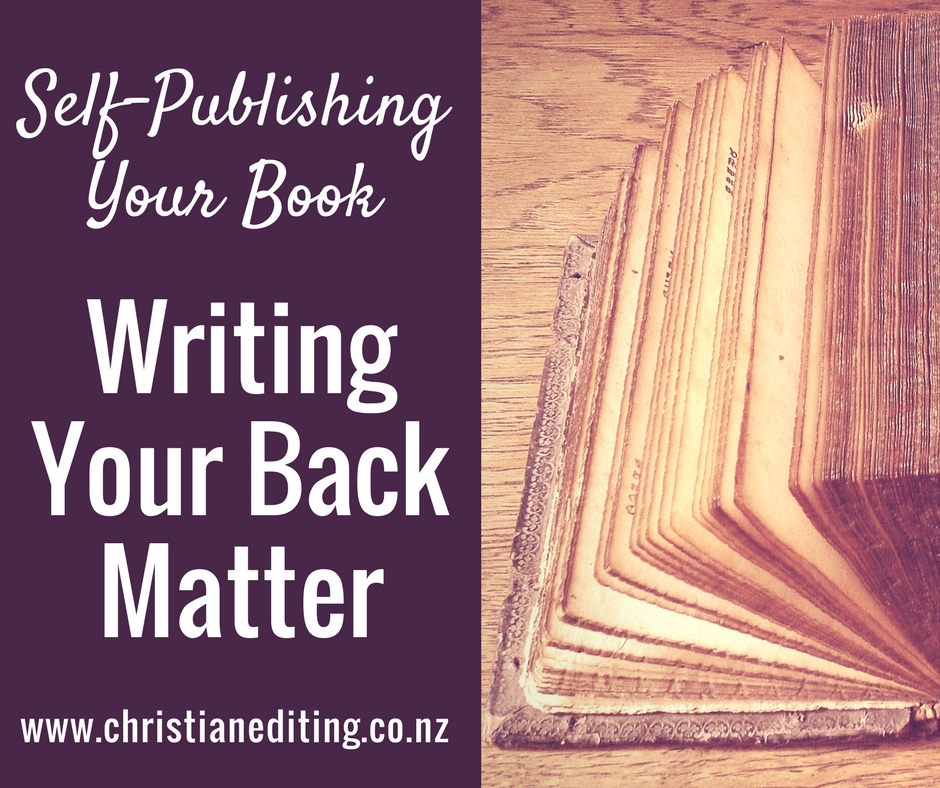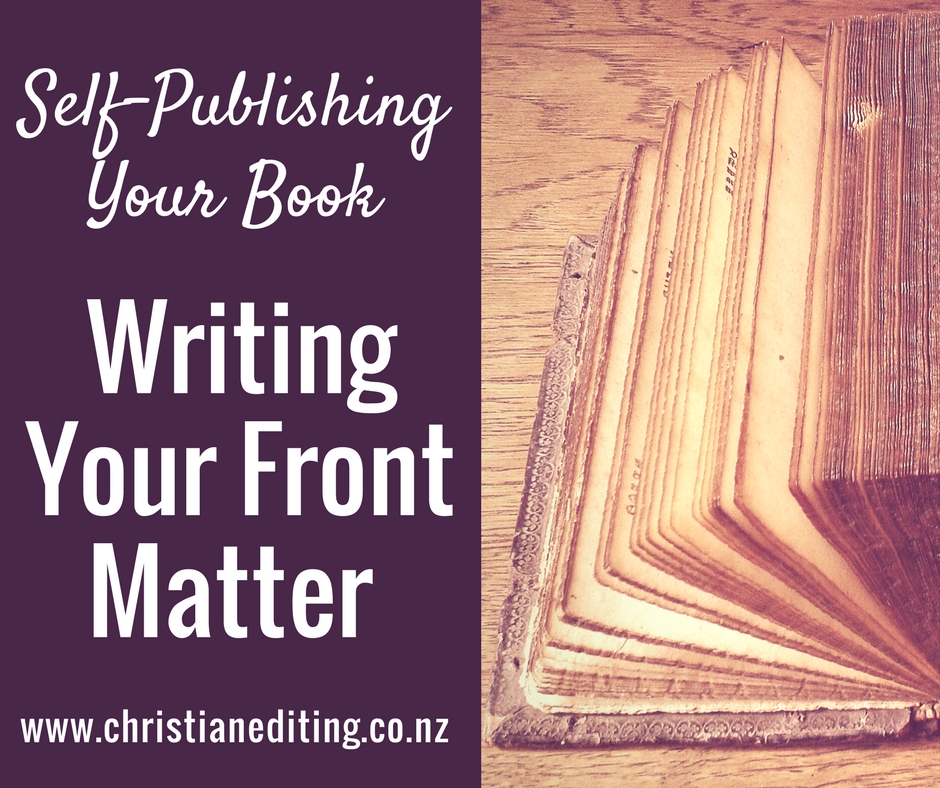Over the last two weeks, I’ve covered what needs to be included in your book’s front matter, and what needs to be included in the author information. Today we’re looking at what else goes in your back matter (also known as end matter).
Back matter is the information at the end of a book, what comes after the final page of the story. It’s also called end matter (you know, because it’s at the end). Back matter or end matter can include:
- Author’s Note (covered last week)
- Acknowledgements (covered last week)
- List of books by the author
- List of comparable books from the publisher (for trade published books)
- About the Author (covered last week)
- Link to author website
- Link to publisher website (for trade published books)
- Social media links
- References or end notes (non-fiction)
- Index (non-fiction)
- Review request (especially in self-published books)
- Email list invitation (especially in self-published books)
- Discussion Questions
- Book Excerpts
Back matter is prime selling space. If your reader has enjoyed the book (and we hope they have), they want to find out more about the book, the series, and the author. The back matter is your opportunity to capitalise on that interest and turn a reader into a fan.
Good back matter sells books. And this starts with the book list.
Book List
There is probably some fancy psychological term for what comes down to pleasure.
If the reader enjoyed your book, they want to replicate that feeling of enjoyment the easiest way possible: by buying and reading another of your books. As an author (and especially if you’re a self-published author) you need to capitalise on your reader’s lack of impulse control.
Your back matter should include a list of all your books, especially if this novel is part of a series.
Include a list of all the books in the series in reading order. You can also include older books, either in series order or in reverse order of publication (i.e. newest first).
If the book is part of a series, make sure you include information sales on the next book in the series (e.g book description and release date). The best time to persuade a customer to buy your next book is when they have happy feelings about the current book. We will not discuss how much money I spend this way.
If your book is an ebook, make this list into hyperlinks to a retail site (Amazon, or whichever site the book was purchased from). If the book is part of a series, include the buy link or pre-order link to the next book in the series. If it’s not yet available for pre-order, direct them to a page on your website where they can sign up for your email list so they are the first to know when the new book goes on sale.
A great book followed by comprehensive back matter is your best marketing tool for the next book. Take advantage of it. Make it easy for your readers to buy your next book.
A trade publisher may also include links to other books in the same genre by other authors from their publishing house. Your objective as an author is to sell your books. Their objective as a publisher is to sell books: yours, and those of all their other authors.
Email List Signup Link
Self published authors realise the importance of having an email list. Savvy authors will include a link to their email list in their back matter. They may also offer an incentive for people to sign up to the list e.g. a free novel or novella.
(You can sign up for my email list in the box on the right.)
Review Request
Positive reviews from customers are an important feature of Amazon, and other retail sites. Less than one reader in a thousand will review a book simply because they enjoyed it—mostly because they don’t know how adding their review helps an author.
Adding a request for a book review on Amazon, Goodreads, or your favourite online bookstore will help boost your review rate. This, in turn, will make your book look more popular (which can help with sales), and will increase your chances of getting a BookBub advertisement.
Discussion Questions
The rise of book clubs means a lot of novels include discussion questions at the back of the novel. These make it easy for the book club host to facilitate the discussion. Discussion questions usually take two pages of a standard paperback.
Book Excerpts
Some authors and publishers include excerpts from other books as a hook to entice the reader to buy now. This is obviously an evil plan designed to part readers from their money. This is a great idea, but don’t go overboard. I’ve read novels with so many excerpts that it affected my perceived pacing of the novel and therefore my enjoyment.
I suggest including one chapter. This could be:
- The first chapter from the next book in the series
- The first chapter from an unrelated standalone title in the same genre.
- The first chapter of the first book in another series.
Publisher Information
A trade publisher may also include their own website information, an invitation to sign up to their email list, or an invitation to join their book blogger/review programme.
References/End Notes
A novel might include a list of reference either in the Author’s Note, or separately. Fiction authors usually include just a simple list of book titles and authors, ordered alphabetically on the title.
References in non-fiction are more complex. They need to include more information—title, author, publisher, year, and the exact page or chapter reference. They are formatted according to the publisher’s style guide. This could be the Chicago Manual of Style (CMOS), Associated Press Style (AP), the Christian Writer’s Manual of Style (CMS), another style guide, or an in-house publisher guide.
Paperback or hardcover non-fiction books may include footnotes, but these can mess with the formatting in ebooks. Many newer books use endnotes instead. These may be at the end of each chapter, or at the end of the book, but before the index.
Index
Non-fiction books (other than memoir) need an index.
Indexing is a specialised skill, and should be completed by your publisher or a qualified freelancer. The convention is that the index is at the very end of the book. This makes it easy for readers to find the information they are looking for.
Conclusion
I have come across some small trade publishers which do not include back matter in their books. This, to my mind, is a problem. They are missing out on potential sales. They are also depriving you, the author, from the opportunity to connect with readers.
If you’re trade published, ask (or getting your agent to ask) what information your publisher includes in their back matter, and what you will need to contribute (e.g. discussion questions).
If you’re self-published, you get to choose. If I haven’t convinced you, maybe this infographic from Bookbub will:



